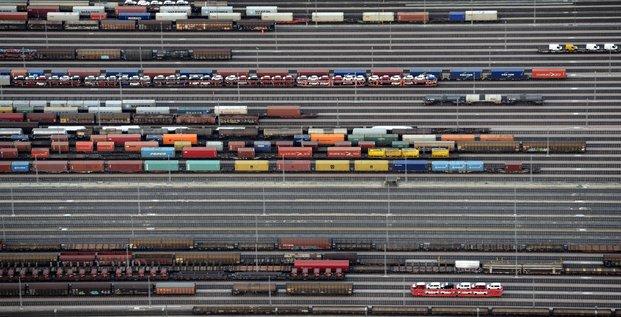Freight development, reconquest of fine services of the territory, ecological transition, predictive maintenance, circular economy: these are only some challenges that the sector must meet within ten years.Leitmotif?Innovation to always improve competitiveness.
Two innovation grand prizes were awarded by the European Railway Clusters Initiative (ERCI) cluster, which brings together 16 rail clusters from 17 European countries.The European jury of independent rail experts, from the world of industry, research or public institutions, have decided 23 candidates.
Smart system for rail freight
The German company PJ Monitoring received the prize for the best SME.PJ Monitoring developed 15 years ago, from a spin-off from the University of Technology of Graz in Austria.The decisive factor for the jury was the development of a global digital system, capable of analyzing intelligent freight wagons.WaggonTracker, the solution, is indeed the first and the only system in the world to fulfill complete surveillance functions and to automate complex maneuvers in freight trains.The system provides information on automated processes in real time, such as maneuvering, walking or stopping position, vehicle performance, last report, etc..With time saving and key safety.
To read |The rail sector is organized to keep a train in advance
In the category of large companies, it was Bozankaya who received the votes of the jury.Created in 1989 in Germany and arrival in Turkey in 2003, Bozankaya develops and manufactures environmentally friendly vehicles, saving energy and operating without noise.Its range, marketed all over the world, extends from the metro to the tram, without forgetting electric utility vehicles such as the tram-bus and the bus.The company now has nearly 1.000 employees in its research and development center, including nearly 100 engineers.
Plan land transport and predictive maintenance
The jury also awarded three favorites.First, for the northern startup Everysens (member of the I-Trans competitiveness cluster) and its Rail-Routes TVMS solution, making it possible to plan and pilot land transport from start to finish: its TMS (Transport Management System) is notOnly collaborative and dedicated to chargers, but it displays real -time information.Thanks to artificial intelligence technologies (AI) and the Internet of Things (IoT), it offers intelligent planning possibilities.

Favorite then, for the German company Pantohealth, also congratulated for its predictive maintenance solution, a key factor in rail competitiveness where the breakage costs very expensive.The system consists of sensors and cameras capable of capturing real -time surveillance information on equipment and associating it with synthetic data, namely artificially created rather than generated by real events.The whole is restored in a synthetic surveillance table.The solution also simulates train interaction with the infrastructure.
Finally, the Italian society.Whether.iron was also noticed for its innovation in signaling and railway telecommunications systems, dedicated to metros and trams.BIM type software makes it possible to model projects, by intelligently managing documentation, automation, design, etc..
"This year again, the cuvée of" Erci Innovation Award "has been very technologically, economic and societal impact.At the heart of digital technology, the proposal for the value of the winners shows us the importance of a European collaboration to succeed in the digital transformation of the railway, ”comments Abdelkrim Talaalout, head of the Autonomous Train program, Railenium.and president of the ERCI Innovation Awards jury.
Optimize electrical energy in the rail
For its part, in another session of the forum, Railenium, the technological research institute (IRT) of the rail sector, highlighted some of its projects, carried out as part of the European collaborative program of the railway sectorShift2rail.
One of the subjects covered concerns the optimization of electrical energy, or how to manage energy flows.The objective is to regulate this energy at best, for the needs of the network, including the circulation of trains and the infrastructure.One of the applications in partnership with SNCF Réseau is to check the right energy recovery return from braking.In summary, the modeling of behaviors of electrical infrastructure, rolling stock and rail buildings, aims to set up multi-source and multi-consumers management management.
Another project relates to the anticipation of the behavior of the ballast, these pebbles placed under the railroad rails.The ballast has an essential role in stabilizing the railway track.A 3D digital model has been designed on the basis of real grain and laboratory testing to simulate the behavior of the ballast.The ultimate objective is to aggregate all this data to predict the evolution of the ballast.Which can be particularly relevant in the context of reuse of this material in a circular economy approach.
To better diagnose track defects, Railenium also works on a mobile cart prototype, which can move on the lane and equipped with ultrasonor -sans contactless intelligent sensors.The whole will be able to carry out a reliable inspection of the rail, which can considerably alleviate human controls.Indeed, preventive maintenance makes it possible to anticipate the problems, in order to maintain the network optimally.
New BIM standards?
"BIM standards (Building Information Modeling) are not yet deployed in the railway environment: it is however a lever to go towards digital continuity and manage information on the life cycle of infrastructure which covers their design, their exploitation andtheir maintenance ", underlines Florence Masbernat of Railenium.The technical center, in this perspective, has designed two demonstrators (on a track device and a linear track): they assess the compatibility of current models with the new BIM standards from the work of the IFC Rail International Standard.
Another critical function of the train is to ensure the surveillance of its integrity, namely that the train remains complete and that no wagon has been lost.The evolution of the European Standard for Traffic Management (ERTMS) aims to increase the capacity of the rail network: this leads to using the equipment on board the train to check that everything is in order.In this new context, Railenium has therefore designed for a strategy of identification and traceability of security requirements, respecting rail regulations.
And Florence Masbernat de Railenium, to conclude: "All these projects demonstrate the interest of promoting research and collaborative innovation, fundamentals of Railenium and comfort our perspectives in the new European program Europe's rail from 2022.»»
7 minutes
To share :
